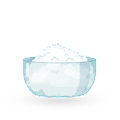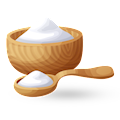MAIN INGREDIENTS
Gelatin dessert is a sweet food that's made using gelatin, a protein obtained from animal collagen.
This protein has the ability to gel or solidify liquids, making it a popular ingredient in various desserts. The use of gelatin dates back to ancient times. As early as the 1400s, gelatin was extracted from animal bones and used in various culinary applications in Europe.
VARIATIONS OF Gelatin dessert
Originating from Minnesota, cookie salad is a simple dessert beloved by children made by combining fudge stripe shortbread cookies, buttermilk, vanilla pudding, whipped cream, and mandarin oranges. Additional ingredients may include berries, but Oreo cookies are strictly prohibited.
MAIN INGREDIENTS
The intriguing fortune cookies are crispy folded wafers hiding an entertaining "fortune" inside. The "fortune" is a written note; a proverb or a universal prophecy believed to predict the person’s future. The cookies are made with egg whites, flour, sesame oil, and sugar, and have a slight vanilla flavor.
They are rolled in flat, perfectly round shapes, then baked. Before they are folded, when they are still hot and pliable, the written fortune is nestled inside the cookie. As they cool, the fortune cookies harden and achieve their distinctively crunchy texture.
MAIN INGREDIENTS
Jell-O is an extremely popular, branded, simple gelatin dessert from the United States. Gelatin, the main ingredient in Jell-O is made by extracting collagen from the boiled bones of animals. Jell-O was invented in 1897 by Pearle Wait, who experimented with gelatine and invented a new, fruit-flavored dessert.
His wife May loved it and named it Jell-O. The couple sold the patent and the name to their neighbour, Frank Woodward, who excelled in marketing the new product via ads, recipe books, and Jell-O molds. Because of his marketing techniques, Jell-O became one of the most popular brands in American history.
Despite its name, Watergate salad is a summertime dessert consisting of a combination of mini marshmallows, pecans, and chunks of pineapple in a base of pistachio pudding. This dessert started its way to popularity in 1985 or 1986, when Kraft put a recipe for the dish on the box of JELL-O Pistachio Flavor Pudding.
In 1993, the name of the recipe was changed to Watergate salad, and it has stuck until today. Nowadays, Watergate salad is especially popular at Thanksgiving dinners and Easter.
MAIN INGREDIENTS
Glossy, red, and sweet, candied apples, also known as jelly apples, were invented in New Jersey in 1908, when William Kolb, a candy maker from Newark, made a syrup with melted sugar, red coloring agent, and cinnamon flavoring. He dipped some apples into the syrup and placed them on his shop's window display.
As the treats were priced at a nickel a piece, they spread to the Jersey Shore and were soon adopted by traveling circuses and numerous candy shops throughout the country. The best candied apples should pair the sweetness of their thin and shiny coating with a tart and crisp varieties of apples such as Gala, Granny Smith or McIntosh.
Bourbon ball is a sweet candy originating from Kentucky. It consists of bourbon, pecans, wafer crumbs, butter, and chocolate. This treat was originally invented by Ruth Booe from the Rebecca Ruth Candy Company in 1938. Today, it is a favorite amongst the Southern families, and it is traditionally prepared and consumed during the festive holiday seasons.
Considered to be both a salad and a dessert, ambrosia is a staple of numerous potlucks and a Christmas tradition in the Southern United States. It typically consists of pineapples, mandarin oranges, coconut, and mini marshmallows, but it can also be enriched with ingredients such as bananas, strawberries, pecans, cherries, whipped cream, yogurt, or cottage cheese.
The name of the salad means fragrant or delicious, and it was also the magical fruit of Greek gods. In American cookbooks, ambrosia first started to appear in the late 19th century, when citrus fruit became more available, and today it is regularly prepared during the Christmas festivities in the American South due to ingredients which were once thought of as luxurious and exotic.
This unusual American dessert salad is especially popular in Minnesota. It consists of cream cheese, graham crackers, milk, strawberries, and strawberry gelatin, although it can be enriched by the addition of canned pineapple, walnuts, or marshmallows.
The combination of these ingredients is typically refrigerated in order to set. Strawberry delight is sometimes prepared for Thanksgiving and Christmas, and it is still a staple of many potlucks in the American South.
MAIN INGREDIENTS
Graham cracker is a sweet American cracker made with graham flour and usually flavored with honey or cinnamon. The crackers date back to the early 1880s, when they were made with graham flour, lard or shortening, salt, molasses, and oil. They were invented by Sylvester Graham, a Presbyterian minister who introduced them in hopes to end masturbation – he believed that a radical vegetarian diet without white flour and spices would end lustful behaviour.
Nowadays, the crackers are used in the preparation of s'mores, while graham cracker crumbs are used for pies, cheesecakes, and moon pies. In the Philippines, an icebox cake known as mango float uses graham crackers, cream, and mangoes.
TasteAtlas food rankings are based on the ratings of the TasteAtlas audience, with a series of mechanisms that recognize real users and that ignore bot, nationalist or local patriotic ratings, and give additional value to the ratings of users that the system recognizes as knowledgeable. For the “74 Worst Rated American Desserts” list until April 19, 2025, 16,264 ratings were recorded, of which 14,916 were recognized by the system as legitimate. TasteAtlas Rankings should not be seen as the final global conclusion about food. Their purpose is to promote excellent local foods, instill pride in traditional dishes, and arouse curiosity about dishes you haven’t tried.








































































